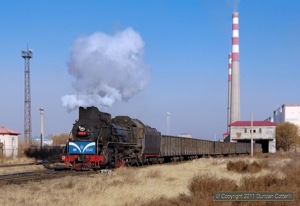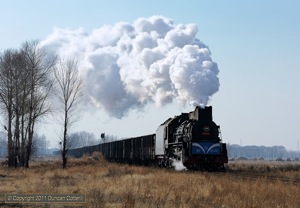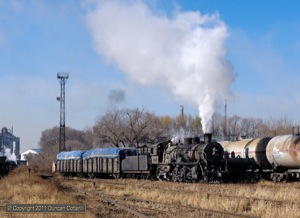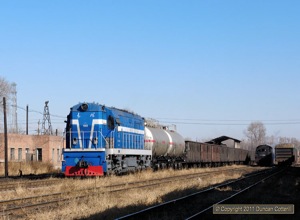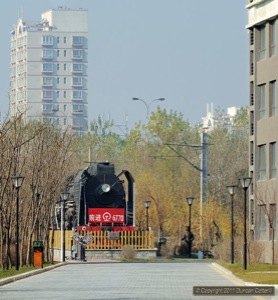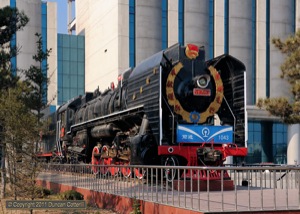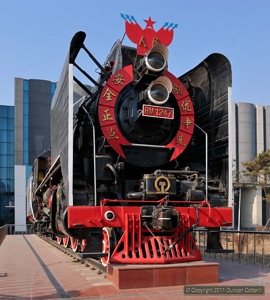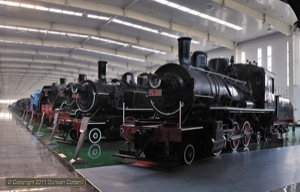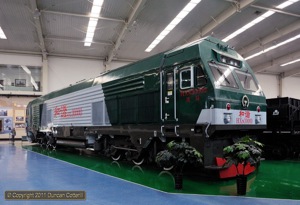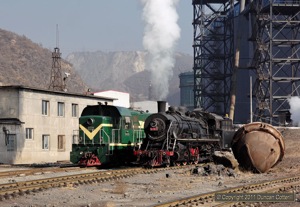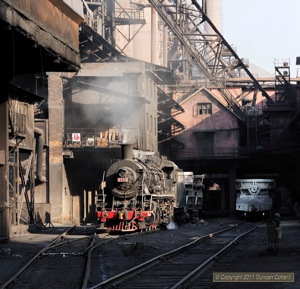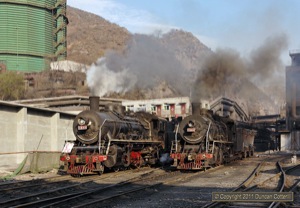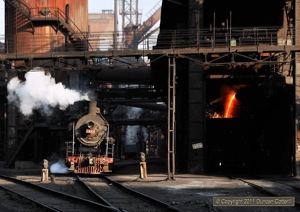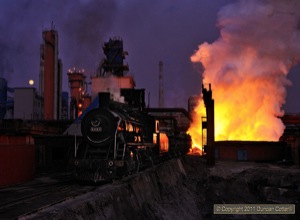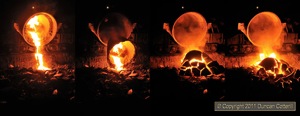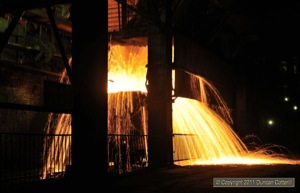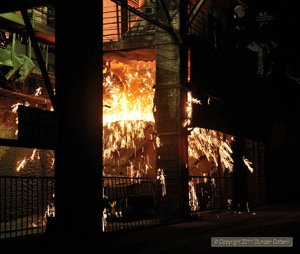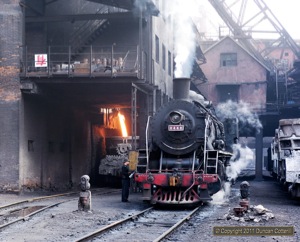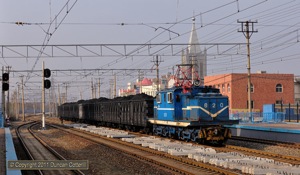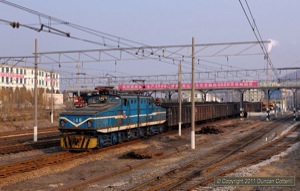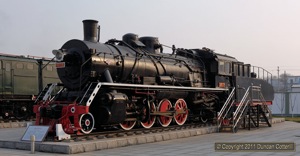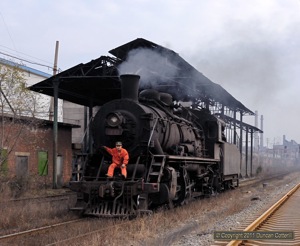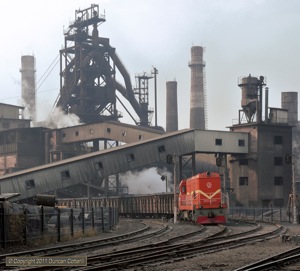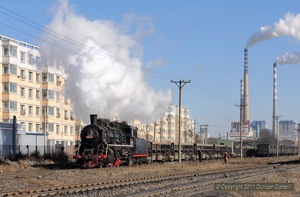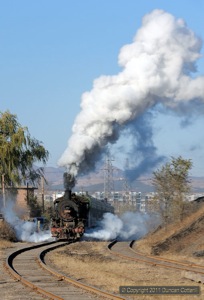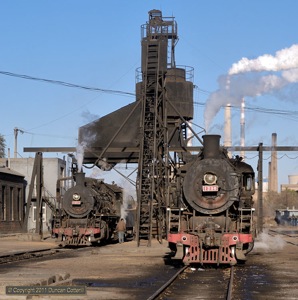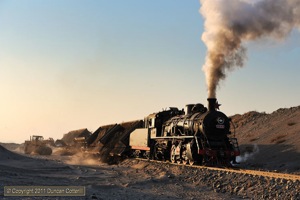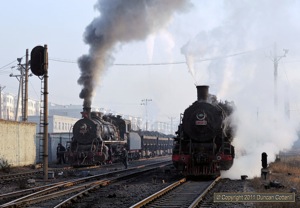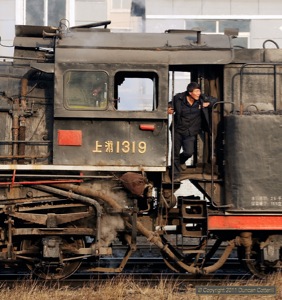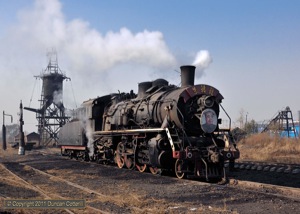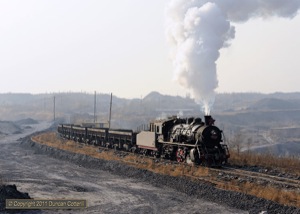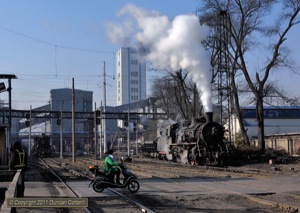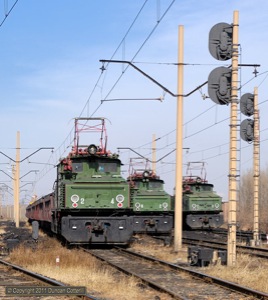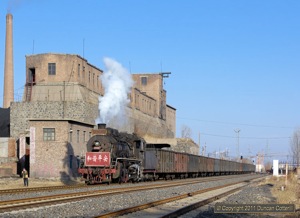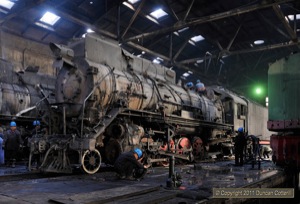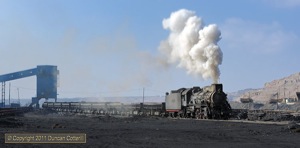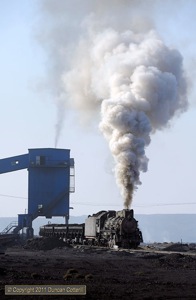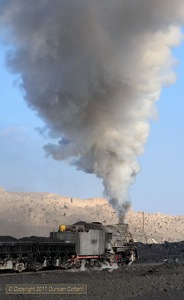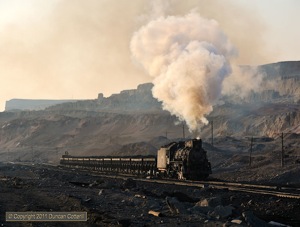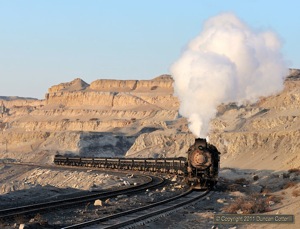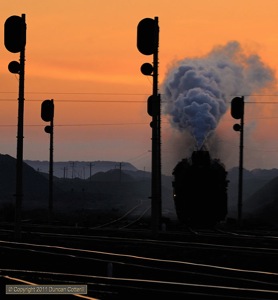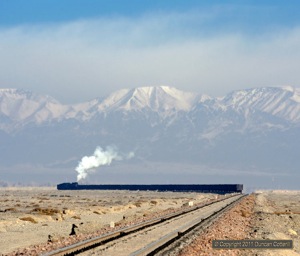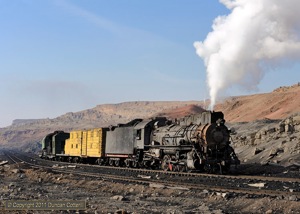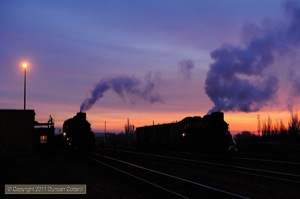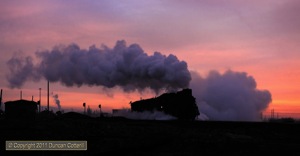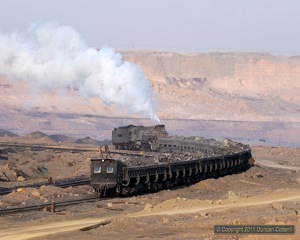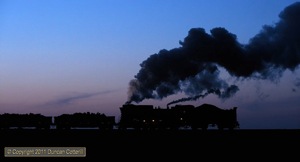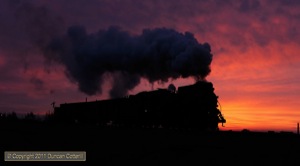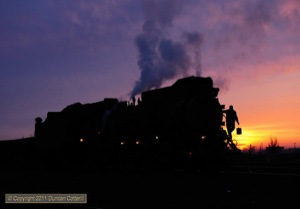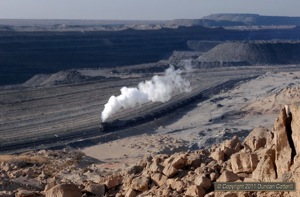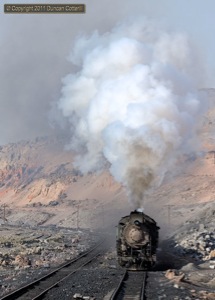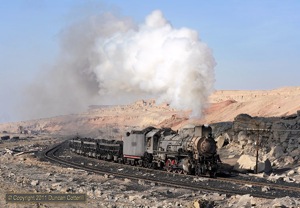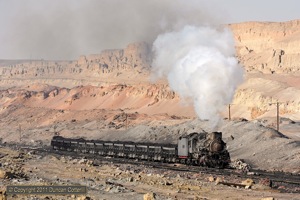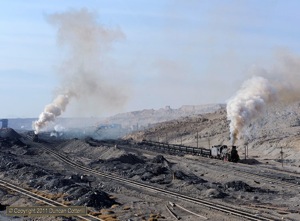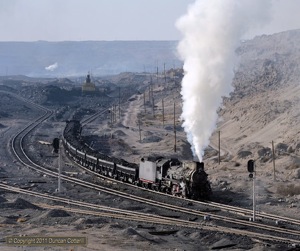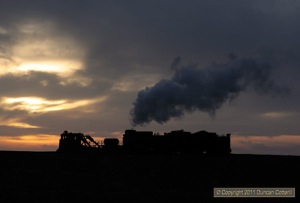Coal, Steel and Steam
04 - 27 November 2012
Report by Duncan Cotterill
Introduction
Chinese steam may be in terminal decline but there are still a few high quality operations good enough to justify another trip. We spent three weeks in the north of the country in November 2011, visiting Fula’erji, Beitai, Fuxin and Sandaoling with fill-in visits to Shenyang, Fushun and Pingzhuang. The usual crew of Sun Xiaolan, Peter Breeze and myself were joined by Robin Gibbons, Adrian Freeman and Don White for various parts of the trip.
Outward Bound
After the very unsatisfactory experience of flying to and from China with KLM last year, we decided to go to HEL this time. Flying with Finnair via Helsinki cost a bit more but it was worth every penny not to be messed about. After an on time arrival at Beijing, we met Xiaolan and took flight CZ6220 to Ha’erbin. There we transferred to train T5007, the 17:25 to Qiqiha’er, hauled by DF11 0164 and formed of a rake of DMU coaches with a conventional soft sleeper, converted to day seating, and a dining car on the front. From Qiqiha’er we took a taxi to Fula’erji.
Fula’erji
Fula’erji is an industrial town on the Nenjiang (Nen River) about 30 km south-west of Qiqiha’er. In railway terms, it’s on the Ha’erbin – Manzhouli line, about 15 km west of the junction with the Qiqiha’er - Baicheng line at Yushutun/Angangxi. The town is home to a number of large industrial plants, several of which have their own rail systems. We spent three days in Fula’erji, from 6 to 8 November.
Fula’erji Erdian (No. 2 Power Station)
The No. 2 Power Station is 7 km south-west of the town centre, next to the Nenjiang, and is connected to the CR system via an 8 km long branch that runs south from a junction with the main line at the west end of town. CR diesels (Class DF5) bring loaded coal trains down the branch to Jiaojie, a yard close to the halfway point, where traffic is handed over to one of the power station’s steam locos for the last 4 km to the power station.
Inbound coal trains aren't particularly frequent (I'd estimate 2 - 3 every 24 hours) but they are impressively long at 50 - 60 wagons a time, weighing in at around 4000 tons per train. Loaded trains are broken up upon arrival at the power station and the wagons shunted to a number of unloading points within the plant. Once empty, the wagons are recombined into a single train and taken back to Jiaojie. The whole cycle takes around 3 - 4 hours to complete.
The power station has five locos with three apparently serviceable and two in use at any one time. JS 6545 and 6546 were in use during our visit. Both locos were fairly clean and had attractive blue and white front boards. JS 6546 had a 6/2011 overhaul date. Both working locos faced west so loaded trains were tender first but the shunting and the return empties were chimney first. SY 1312 and JS 8123 were cold in the depot yard. Both appeared complete but obviously hadn’t been used for some time. JS 8355 was inside the shed and appeared serviceable (it was actually seen in use a few days after our visit). Staff indicated that there were difficulties getting spare parts for the locos and transporting them to works for major overhauls was problematic. The first diesel was said to be due in December.
Like many industrial locations, there could be little or no movement for hours on end but when a train did arrive, there was a period of hectic activity until all the wagons had been positioned, then it all went quiet again until it was time to assemble the empties. Most of the steam activity could be photographed from the west end of the power station yard, technically just inside the perimeter fence but still far enough away from the power station buildings to avoid unwelcome attention. We did manage a quick visit to the loco depot, deep inside the plant but were soon thrown out.
Fula’erji Yidian (No. 1 Power Station)
The No.1 Power Station is situated on the north bank of the Nenjiang in the heart of the industrial area, between the steelworks and the heavy engineering works. SY 0853 from No.1 Power Station was seen at No.2 Power Station where it was being repaired. Staff there told us it is normally spare to a diesel and there is another SY dumped at No.1 Power Station. We couldn't ascertain the number of the dumped engine.
Fula’erji Steelworks
The steelworks is just to the south of the town centre, east of the heavy engineering works. Our taxi driver told us he had seen steam locos there so we went for a look. Staff at the steelworks confirmed that they still had one serviceable SY but it was at the depot and was spare to their diesels (DF5 1279 and another of the same class were seen). Permission to visit the depot was refused.
Heilongjiang Chemical Plant, Fula’erji
Heilongjiang Chemical Plant, in the south-eastern corner of Fula’erji, had SY 0897 and SY 1688 in use during our visit. The locos were kept busy shunting wagons around the chemical plant and to/from the adjacent exchange yard, just to the east of the plant. Both locos faced east and both were in poor external condition. SY 0897 also sounded very rough mechanically.
Our presence was tolerated in the exchange yard but we were told not to enter the plant. The steam locos only work as far as the exchange yard with CR DF5 diesels handling traffic between the exchange yard and the CR station/yard. There should be two more SYs stored at the depot but we didn't attempt a visit as it's inside the plant fence.
Fula’erji Main Line
Two passenger trains were seen, one with orange DF4B 2636 was identified as train 6255, the 15:22 from Qiqiha’er to Zhalantun. The other, 4192/4193, 04:50 Manzhouli – Suifenhe, was hauled by a DF4D. No freights were seen but we heard plenty of them going past on the main line while we were on the No.2 Power Station branch. The distinctive growl and horn of HXN5s on many trains was unmistakable. Shunting and trip working in the Fula’erji area appeared to be handled exclusively by class DF5 diesels.
Fularji to Shenyang
We left Fula’erji by taxi to Qiqiha’er and then travelled to Shenyang Bei overnight on train T312, departing at 20:38. DF4D 3320 provided the power from Qiqiha’er and SS9G 0188 was on the front when we arrived at Shenyang, presumably having taken over at Ha’erbin. At Shenyang we met up with Robin and our driver for the next ten days.
Shenyang Area
We spent Wednesday 9 November exploring a number of locations in the Shenyang area.
Huanggutun Power Station
Staff at Huanggutun Power Station confirmed that SY 1232 was no longer in use (as suggested by David Thomas’s report). The shot we had hoped to get with the SY parked below the viaduct with a CRH high-speed train passing over the top was also impossible due to recent construction work in the area.
Shenyang Cast Museum
QJ 1316 was found plinthed at the Cast Museum (as in cast iron), not far from the power station, but it was in the middle of a construction site so we couldn't get close.
Lingkongyi Jie
Travelling round the southern ring road, en-route to Sujiatun, we spotted two locos, QJ 6757 and QJ 6770, plinthed in a new housing development in the middle of the trianguar junction between the western freight avoiding line and the main line south from Shenyang (old station) to Hun He. Once again, we weren't permitted to go in but the numbers were clearly visible from the street outside (Lingkongyi Jie in Heping District).
Sujiatun Repair Factory
Our attempts to arrange a visit to Sujiatun Repair Factory came to nothing and staff at the museum told us that the works had closed after completing restoration work on UH 02, the ex-Benxi Steelworks fireless, for the museum a few weeks ago. Earlier enquiries about a visit got an equally negative response. I don’t believe the Repair Factory has closed and don’t understand why we got such a negative response.
Shenyang Main Line
There were a lot of the new Dalian/Bombardier class HXD3B electrics around the Shenyang area on freight and a few passenger trains. SS4Bs were still very common on freights as well. On the line south to Benxi, a number of class HXN3 diesels were seen on freight.
Shenyang Railway Museum, Sujiatun
At Sujiatun we attempted to visit the museum but were told it was only open to the public on Saturdays and Sundays. After a lot of persuasion, we were permitted a short visit. QJ 1043 outside appeared to actually be QJ 6540 in disguise (air receiver plates and build date). Other locos in the extensive collection were RM 1247 (also outside), QJ 6368, SY 1096, JS 5003, GJ 1038, XK13 3858, DK5 250, SL8 811, JF6 3329, ST2 22, SL7 751, FD 1227, JF2 2525, SL5 292, JF3 2558, DB1 28, PL1 220, UH 02 (fireless), DF4C 5331, DF6 0003, DF5 1043, DFH3 0186, DF4 1029, ND5 0016, BJ 3242, DFH5 0371, DF7G 5090, SS1 0695 and HXN3 0000. The HXN3 body contained no internal fittings and was apparently built specially for the museum by Dalian!
Beitai Steelworks
From Sujiatun we travelled to Beitai by road, arriving on the evening of 9 November 2011. We had a two day official visit arranged on Thursday 10 and Friday 11 November 2011. Adrian and Don joined us on the morning of 10 November prior to the steelworks visit.
Nine different steam locos were seen in use, SY 0448, 0825, 1075, 1077, 1191, 1560, 1561, 1567 and 1684, most of which were in good external condition. Several locos were seen with Sujiatun overhaul dates in 2010 and 2011 but SY 1114, overhauled at Tiefa last year, was nowhere to be seen.
Most of our time was spent around the No. 1 Ironworks where the SYs handled all the iron and slag ladles to and from the four furnaces. Raw materials were brought in by GKD1C diesels. Elsewhere on site, the ladles were handled by a mixture of SYs and GKD1Cs. A number of DF10Ds worked heavy trains of coal or iron ore from the CR yard to the stockpiles.
As has been reported, slag tipping takes place into ponds near the No. 1 Ironworks with spectacular results. However, the huge clouds of steam generated when the molten slag hits the water make photography difficult. The most memorable pictures were obtained at dusk when the loco was illuminated by the glow of
the molten slag, reflected off the clouds of steam. The sparks given off when the iron ladles are loaded also make for dramatic photos, particularly at night.
A visit to the depot was requested but declined, however four dumped SYs were seen in the depot area from the nearby road overbridge.
We spent a couple of hours on the "Neverer's Bridge" over the junction of lines south west of the No.1 Ironworks. After around an hour, three police vehicles arrived and around 15 policemen leapt out to arrest the foreign spies, only to find that we had permission to be there and were accompanied by a representative of the steelworks management. You would have thought that the fact that we were all wearing Beitai Steelworks hard hats might have given the police a clue.
Beitai Main Line
On the main line, freight traffic was handled by a mixture of brand new Dalian/GM HXN3s and older ND5 diesels. The only passenger train seen was hauled by an orange DF4B.
Fushun Industrial Railways
From Beitai we travelled by road to Fushun and then spent Saturday 12 November 2011 exploring various industrial lines.
Fushun Mining Railway (Kuangwuju)
Our first destination was the Mining Railway's Kuangwuju station in the city centre. We found the station signs and timetables removed and the rails through the platform tracks rusty. The EMU operated passenger service appeared to have ceased some time ago. After a long wait, with no trains at all, we were beginning to wonder whether the whole operation might have come to an end but were reassured when vintage ED85 electric 620 passed on an eastbound coal train. Surprisingly, the loco was painted blue instead of the expected green.
Fushun Old Steelworks
Next we went to the west end of town and parked near the mine railway's former western passenger terminus at Jixiu. Again the station looked like it had been out of use for some time. From there we followed Derek Jenkins' directions to the Old Steelworks loco depot on foot, taking about 25 minutes to walk there (thanks Derek). En route, we passed SY 1633 going to shunt some sidings further east. At the depot, SY 1050 was in light steam with nothing to do. SY 0839 was cold outside the shed but it was difficult to tell whether it was out of use as all the locos were very scruffy anyway. Recently overhauled SY 1632 (Sujiatun 2011-08) and SY 1634 were locked away inside the shed. Diesels DFH5 0408 and GKD1A 0209 were also at the depot.
Fushun New Steelworks
After the Old Steelworks, we continued to the New Steelworks nearby but found it was all diesel, worked by orange GKD1A class locos. Staff were very friendly but confirmed that there were no longer any steam locos in use.
Fushun Mining Railway (Guchengzi)
The rest of the day was spent at Guchengzi, site of the washery on the south-western edge of the opencast mine. This is marked on the Quail map as Xinshengqiao, actually the station to the north, at the junction of the lines to Guchengzi, Tiantun and Jixiu. Several mining electrics of classes ZG150-1500 (Xiangtan), 37E (Skoda) and ED85 (Japanese) were seen in use over the 75 minutes we were there, all in blue livery. These included no fewer than three ED85s, 1205, 1206 and 620. A fourth ED85, 1216, was stabled in the former passenger platform. In the opencast mine an orange ZG150-1500 could be seen on a train of spoil tippers. While we were there a coal train came out of the pit, hauled by a class 37E.
We also visited the collection of preserved locos at Guchengzi (admission 30RMB), SY 0628, SY 0715, ZG150-1500 027, EL1 1707, 37E 1526 and ED85 1137.
Fuxin Mining Railway
We left Fushun by road and travelled via Shenyang to Fuxin where we spent 3½ days from Sunday 13 to Wednesday 16 November photographing trains on the Mining Railway.
A total of eleven different SYs were seen in steam: SY 0941, 0988, 1210, 1319, 1320, 1378, 1395, 1396, 1397, 1460 and 1818 (1414). SY 1395 carried "Zhu De" decorations and was permanently stabled at Taiping in steam but with no work to do. The rest were out and about on trains. Two diesels DF5D 0066 and 0067 were also in use. Out of use SY 0895 was seen, apparently in store in a coal yard adjacent to the CR yard at Chengnan, between Fuxin and Ajin. We didn’t check on the stored/dumped locos at other locations around the system.
Passenger train 111, the 09:19 Wangying - Xinqiu was steam on Sunday, diesel on Monday, steam again on Tuesday and almost certainly diesel on Wednesday but train 114, the 13:09 Xinqiu - Wangying, was only steam on Sunday and diesel on Monday and Tuesday. Train 02, the 06:20 Xinqiu - Ping'an was diesel on Sunday, not seen on Monday and steam on Tuesday and Wednesday.
Most freight west of Ping'an was diesel but we did see SYs work a few trips to/from the CR yard. Most freight east of Wulong yard and to Wulong Mine and the nearby tip was worked by SYs but we did see the diesels working coal wagons to/from Wulong Mine on a couple of occasions. Wulong tip seemed to be exclusively steam worked. A handful of SY worked spoil trains were also seen using the tip east of Gaode.
The mine south of the opencast pit is called Xingfu Mine and still has a working 762mm gauge electric system, most of which is confined to the colliery yard and therefore inaccessible. One line does run outside the walled area to what appears to be a shed/workshop in another walled compound a few hundred metres to the west. At least two small steeple-cab locos were seen in the colliery yard and there were what appeared to be fairly standard electric mining locos in the other compound.
The standard gauge line from Gaode to Xingfu Mine is still in use but doesn't appear to see much traffic judging by the slightly rusty railheads.
Another electrified NG line, probably 900mm gauge, comes out of the back of Wulong Mine but we didn’t get the chance to investigate it properly. A couple of steeple cab electrics were glimpsed inside the security fence. (Others have reported this line as 762mm gauge but it looked more like 900mm to me.)
There was a very high level mine inspection going on during the final two days of our visit and the mine authorities appeared to be nervous about our presence around the railway in case the inspectors turned up while we were there. On a couple of occasions we were asked to leave the area around Ping’an, where the locos gather at shift change, and we were even asked to leave the spoil tip at Wulong Mine on the Wednesday morning.
Pingzhuang Mining Railway
From Fuxin we took less than four hours to travel to Pingzhuang via the new expressway. Work on the new coal line that parallels the road north of Chaoyang didn’t seem to have progressed much over the past year and the expressway still ended in a field near Heishui, short of Pingzhuang.
We spent Thursday 17 and Friday 18 November on the Pingzhuang system. SY 0400, 1052 and 1441 were working the surface lines with SY 1025 and 1764 on the opencast side. There was a sixth SY and possibly a seventh in use on the Friday but we didn’t get their numbers.
EL2 electrics 6787, 7324, 7326, 7328, 7362, 7364 and 7370 were in use on coal trains out of the opencast pit. These were running at a rate of around 3 an hour at times but there were also long gaps, such as at lunchtime on Friday when the whole system went to sleep for about two hours.
Traffic on the surface system was as erratic as usual with long periods of inactivity. Getting shots of chimney first locos working also proved difficult as most of the system is uphill for tender first empty workings and most chimney first loaded trains just roll downhill.
Pingzhuang to Sandaoling
We travelled by road to Chifeng and then caught train 2560 overnight to Beijing Bei behind Tongliao allocated DF4D 0128. Then it was off to Beijing Capital Airport where we bade farewell to Robin before catching flight CA1901 to Wulumuqi.
After arrival we transferred to the station and took train K54 to Hami, arriving just after 23:00. I didn’t see the loco close up but assume that it was the same DF11 that hauled the stock into the platform.
It was still light for the first few hours and much evidence of electrification work was visible. Concrete masts had been erected along much of the line and there were many more piled up, just waiting to be installed. A few of the masts had fittings but there was no sign of wiring anywhere, including Hami.
Freight traffic was heavy and we overtook a DF4B hauled freight at almost every loop. A couple of DF4B worked local passengers were seen but not identified. East of Tulufan, DF8B started to appear on freight but it was dark by then and less easy to see what was happening. All shunting along the line appeared to be handled by DF5s.
As well as the electrification work on the existing double-track main-line, there were advanced construction works for the new high-speed railway linking Wulumuqi with Lanzhou visible at various points on the journey, including in the outskirts of Wulumuqi. This will be an amazing line when it’s completed, crossing the Qilianshan mountains at an altitude of over 12000 ft above sea level and eventually bringing Wulumuqi within 12 hours of Beijing by rail.
After spending the night in Hami, we travelled on to Sandaoling by road.
Sandaoling Mining Railway
Despite a general reduction in spoil and construction train activity, Sandaoling is still a great place to photograph trains. We had a five day official visit there from 20 to 24 November.
The spoil operation based at Xibolizhan still employed around half the steam locos on the railway but was noticeably quieter than a year ago. Around 5 or 6 locos would gather at Xibolizhan for the 09:00 shift change every day but then there was very little activity until around 10:30 or 11:00 when the majority of trains left for the pit. Once things got going it was quite busy but early mornings at Xibolizhan were largely a waste of time with little leaving during the glint light period and locos so filthy that they wouldn't have glinted anyway.
The number of construction trains was also reduced. We saw two trains in use, one worked by JS 8188 and the other by SY 1304, the only SY we saw in use. Both construction trains were seen on a number of different occasions. JS 6224, one of only two locos numbered below JS 8000 seen in use, was paired with the Jordan spreader but didn't seem to do a lot. On the last afternoon, JS 8194 took over and the spreader seemed more active than it had been the whole time JS 6224 was in charge.
The morning passenger train continued to run between Dongbolizhan and Xibolizhan but no longer went into the pit. On the Sunday it went beyond Xibolizhan to the bottom of the spoil tips but during the week it turned round at the yard offices. The loco was usually borrowed from the spoil train fleet with JS 8089 being a favourite. On our last morning JS 8188, usually found on construction trains, was used instead.
The 09:00 shift change at Dongbolizhan attracted many fewer locos than that at Xibolizhan but the photographic possibilities were actually better with a fairly clear horizon allowing silhouettes against the sunrise. In addition to the passenger train, there were usually one or two coal trains present for servicing at shift change time.
The coal side of the operation was busier than I've seen it before with four sets of wagons serving two loading points. There were up to four loaded trains an hour when things were going well. Three sets were hauled out of the pit by chimney first locos while the fourth was borrowed from the spoil operation and was hauled out of the pit tender first. The main loading point was always served by a chimney first loco while a large grab nearby would load trains hauled by either chimney first or tender first locos. There seemed to be a lunch break every day between about 13:30 and 14:30 when nothing would be loaded but traffic was intense at other times.
The deep mine operation based at Nanzhan appeared to continue much as before with trains to and from the CR interchange at Liushuquan worked by one of the DF8B diesels and everything else worked by steam locos. Two of the diesels never turned a wheel during our visit and it was rare to find less than three stabled at Nanzhan with nothing to do. The steam fleet appeared to consist of four JS. We didn't spend long on the deep mine system but did see a train of empties leave for Erjing hauled by a tender first JS on one occasion. On another day a longer train was worked from Nanzhan by two JS, one at each end, with the front loco remaining at Erjing with half the train and the back loco propelling the rest to Yijing.
A visit to the works on 21 November found JS 8190 under heavy repair. JS 8027 and JS 8358 were visiting for minor repairs but both were back in traffic a couple of days later. We thought about visiting the store/dump for something to do on a cloudy morning but were told it would cost RMB50 per person. Thanks but no thanks!
Spoil Train Locos : JS 6261c, 8027, 8040, 8076c, 8080, 8081, 8089p, 8194s, 8195p, 8225, 8368p.
Spreader : JS 6224.
Construction Trains : JS 8188p, SY 1304.
Coal Trains : 8077, 8078, 8173.
Nanzhan : JS 8053, 8314, 8358, 8366.
Under Repair : JS 8190.
c = also seen on coal trains,
p = also seen on the passenger train,
s = also seen on the spreader.
The Long Journey Home
“Lucky Escape from Fogtown” might be a more accurate description of the nightmare that blighted the last two days of the trip. The first part of the journey went smoothly enough. We travelled back to Hami by road on the evening of Thursday 24 November then took train K9871 overnight to Wulumuqi, arriving 10 minutes ahead of schedule at 08:00 and leaving plenty of time to get to the airport for our 11:30 China United flight to Beijing.
En-route to the airport, Xiaolan received a phone message informing her that our flight had been cancelled. We knew from a previous experience two years ago that a major delay and lots of hassle were inevitable but never expected things to be as bad as they turned out.
On arrival we were told our tickets had been transferred to an afternoon flight, then this became an evening flight, then a flight early the following day, then a later flight and so on. Don and Adrian were flying back to the UK the next day so they couldn’t wait that long. Xiaolan managed to get them the last two seats available on any flight to Beijing on Friday, in first class and at eye-watering fares, and off they went.
The rest of us were still stuck in Wulumuqi with a vague suggestion that there might be seats available on a flight late on Saturday evening. As we were flying back to the UK on Sunday morning this was getting much too tight for comfort and getting on that flight was still far from certain, so we started to explore other options. Enquiries about Friday flights to other places within easy reach of Beijing, such as Qingdao, Jinan, Dalian or Shijiazhuang drew a blank – there were no seats available, even in first class. Then Xiaolan discovered there were still a few seats on the first Air China flight to Beijing on Saturday morning but we’d have to buy full price tickets. No problem, just get us out of here!
It appears that if you have tickets with one airline and they cancel your flight then you can get transferred but only with standby status. There’s a good chance of getting bounced back for days on end if you’re travelling from somewhere busy like Wulumuqi. So we effectively threw away our original RMB2500 tickets and paid the same again for new tickets on the CA flight in order to be sure of getting back to Beijing in time for our flight home. Actually buying the tickets was less than straightforward as they wouldn’t accept western credit cards so we had to find a cash machine that took VISA and Mastercard and raided it instead, extracting a couple of thousand RMB with multiple cards until we had enough to pay for the tickets. Sorted, or so we thought.
Saturday started foggy and by the time we reached the airport at 07:00 it was obvious that it was very foggy indeed. We checked in and went through to the departure lounge only to watch flight after flight go from “on-time” to “delayed” and eventually, in many cases, to “cancelled”. Nothing landed or took off at all and nobody was working on or around the aircraft that were visible. We were effectively trapped in a dead airport.
By mid-afternoon nothing had changed and it looked like we’d be stuck in Wulumuqi for at least one more night and maybe a lot longer. Then we’d have to go through the whole sickening transfer process again and still be faced with the problem of getting home from Beijing at the end of it. Given the number of passengers that needed rebooking and the problems we’d had the previous day, we could have been be there for days. The trains would inevitably be full and the prospect of a 1200 mile taxi ride to Lanzhou even started to look attractive. The only thing that gave us any hope at all was that our plane was still at the gate and it was still shown as delayed rather than cancelled. If the weather improved, at least we still had a faint chance of getting away.
Then, around 15:50, there was an improvement in visibility. There had been improvements before but this time the fog didn’t close in again. The visibility continued to improve and it started to look like there might be a chance of planes taking off. Frustratingly, nothing was happening on the apron and the opportunity to escape appeared to be slipping away.
There was a perceptible buzz in the departure lounge around 17:00 when the airport burst into life. Fuel and catering trucks appeared and started to service several aircraft, including ours. The feeling turned to real excitement around 17:30 when a crew boarded our plane and within a few minutes we were boarding ourselves. There were no guarantees but at least we were in with a chance of getting out!
At 18:00 we pushed back, the first aircraft to do so, and made for the runway. First we needed de-icing and the delay pushed us back from first to third in the queue. The fog seemed to be closing in again and, when it appeared that we were heading back to the terminal, the atmosphere on board became subdued. There was an audible groan as we slowed at the turn for the terminal but, instead of turning, we carried on to the opposite end of the runway, where the visibility was slightly better. After a few agonizing minutes that felt like hours, we roared off into the infinite grey yonder, willed into the air by 180 desperate passengers as much as by the thrust of a couple of jet engines.
The tension on board broke when we emerged from the perpetual greyness into a clear blue sky with a beautiful view of the snowcapped peaks of the Tianshan rising out of a sea of fog and illuminated by the setting sun. The rest of the journey to Beijing was a total anticlimax except for a very hard landing at Capital Airport, for which the pilot was instantly forgiven.
The Air China ground and air crews have to be commended for the speed with which they got things moving once the airport reopened. Checking on FlightStats afterwards, it appeared that around nine flights got away over a period of around 30 minutes but then there were no more, everything else was cancelled. Wulumuqi normally handles 150 to 200 departures every day, so to be on one of the handful of planes to get away was incredibly fortunate.
After much celebration and a rather short night at the Capital Airport Hotel we headed back to the airport to catch the Finnair flight back to Helsinki for our connecting flights back to the UK. This was flying as it was meant to be, punctual, relaxing and totally uneventful.
Comments and Conclusions
Apart from the last two days, which also cost us our planned visit to Qian’an, it was a very enjoyable and productive trip. Beitai, Fuxin and Sandaoling were excellent and produced so many good photos I almost ran out of space to back them up. The other locations were visited more out of interest than in the expectation of good photos but we got a few worthwhile pictures, especially at Fula’erji and the electrics at Fushun, although one of our number was heard muttered scathing remarks about horrible tin boxes.
The weather was unusually warm everywhere we went with overnight temperatures only just dropping below zero and daytime levels almost getting into double figures. The north-east did get significantly colder after we’d left with temperatures below -15C and heavy snow across the region but, even when we got back to Beijing at the end of the trip, temperatures still barely dropped below zero overnight.
Despite the relative warmth, we only lost the exhaust on a handful of trains during the entire trip so it hardly inconvenienced us at all and, thankfully, rendered the dreaded thermal long-johns redundant. There were some cloudy periods, particularly at Pingzhuang, but overall the weather was mainly sunny. Snow was almost totally absent although there were flurries on a couple of occasions but not enough to make a difference.
The Wulumuqi fiasco highlighted the importance of having enough readily available cash in reserve to be able to buy yourself out of trouble. Between us we had to raise over RMB17500 (£1800) to escape, most of which we hope to get back on our insurance. When things go seriously wrong, China can be a very unforgiving place, particularly if you’re competing for attention with a crowd of locals who’ve also just been dumped on but know the system and can speak the language. If we’d relied on getting free transfers to other flights, we could have been there for days and then had to pay even more for new tickets back to the UK.
As time goes on, it’s getting progressively more difficult to find steam locations worth visiting in China. Even when someone does discover a new place like Fula’erji, the diesels usually arrive within months. However, it is still possible to find more than enough top quality steam action, even at the end of 2011. Anyone thinking of going to China this winter shouldn’t worry about being too late. Instead, put the effort into going to the best places at the right time and you can still have a wonderful trip, even at this late stage.
Don’t leave it too late though, there are unlikely to be as many opportunities next winter. And keep all your fingers crossed if you have to use Wulumuqi Airport. Three days after we escaped, the fog still hadn’t dispersed and there were about 16000 passengers stranded there.
